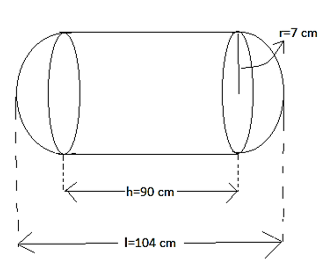A solid is composed of a cylinder with hemisphere ends. If the whole length of the solid is 104 cm and the radius of each hemispherical end is 7 cm, find the surface area of the solid.

Total length of solid = l = 104 cm as shown in figure
The solid consist of a cylinder and two hemispheres
Let the height of cylinder be h
We get the height h by subtracting the radii of left and right hemisphere from the total length l as seen in figure
∴ h = 104 - (7 + 7) cm
∴ h = 90 cm
Let r be the radius of hemisphere and the radius of cylinder
∴ r = 7 cm
There are two hemisphere one at left and one at right both of same radius r and two hemispheres make one sphere
Surface area of sphere = 4πr2
The flat circles i.e. the upper and lower circles of cylinder are not to be considered in the surface area of whole solid as they are covered by the hemispheres therefore for cylinder we will take its curved surface area
Curved surface area of cylinder = 2πrh
Surface area of solid = surface area of sphere + curved surface area of cylinder
= 4πr2 + 2πrh
= 2 × (22/7) × 7 × (2 × 7 + 90)
= 44 × 104
= 4576 cm2
Therefore total surface area of solid = 4576 cm2